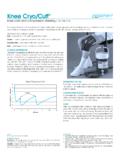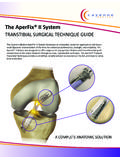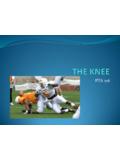Transcription of The Guide to Rehabilitation of Anterior Cruciate Ligament ...
1 Chester Knee Clinic & Cartilage Repair Centre Nuffield Health, The Grosvenor Hospital Chester Wrexham Road, Chester, CH4 7QP, Hospital Telephone: 01244 680 444. CKC Website: Email: The Guide to Rehabilitation of Anterior Cruciate Ligament (ACL) Reconstruction INTRODUCTION. Anterior Cruciate Ligament surgery and Rehabilitation have undergone dramatic changes over the past decade, due to extensive clinical experience, improved surgical technique and better understanding of Rehabilitation . Pre and post-operative Rehabilitation is a major factor in the success of ACL reconstruction.
2 Early restoration of full joint movement and weight-bearing are of paramount importance for successful Rehabilitation . We aim to ensure a complete understanding of the basic principles of the ACL reconstruction, to restore the full range of motion, near normal strength and to mentally prepare the patient for the operation and accelerated Rehabilitation . The major goals of ACL surgery and Rehabilitation are: to restore normal joint anatomy, to provide static and dynamic knee stability and return to work and sport as soon as possible.
3 It is very important that the patient takes an active part in the Rehabilitation , both before and after the operation. Our goal is to Guide our patients through the Rehabilitation without unnecessary restrictions. Therefore, this is not a protocol or a strict regime, but an overall Rehabilitation Guide . This program is based on accelerated Rehabilitation principles and extensive experience of Donald Shelbourne, MD and Mark De Carlo, MHA PT SCS ATC, of the Methodist Sports Medicine Center, Indianapolis, Indiana, USA. Please see for more information.
4 ABOUT THE ACL. The knee is a complex joint, which has the ability to bend and rotate slightly. Knee ligaments help control motion by connecting bones and bracing the joint against abnormal types of motion. The ACL links the back of the femur (thighbone) to the centre of tibia (shinbone), stabilising the knee, mainly in the forwards and backwards direction. In addition to its mechanical restraining function, the ACL provides important neurological feedback that directly affects perception of joint position, and reflex muscular stabilisation of the joint or proprioception.
5 Conscious and subconscious proprioception is essential for normal joint function in daily activities, occupational tasks and sports. Proprioception diminishes following capsulo-ligamentous injury, but is significantly restored following surgical ACL. reconstruction and Rehabilitation . A typical mechanism of an ACL injury is a non-contact twisting movement, usually due to abrupt deceleration and change of direction. Side-stepping (cutting), pivoting and landing from a jump are examples of events that may cause an ACL tear.
6 An audible pop or crack, pain and the knee giving way are typical initial signs, followed by almost immediate swelling, due to bleeding inside the joint. Associated damage to other important joint structures, such as collateral ligaments, menisci, and articular cartilage is very frequent. Some patients achieve satisfactory stability and function with non-operative treatment ( Rehabilitation and adjustments to daily activities and sports). However, chronic ACL deficiency results in gradual damage to the menisci and articular cartilage and consequent early joint degeneration.
7 ACL RECONSTRUCTION. ACL reconstruction is not an emergency operation. Delaying surgery until a full range of motion is obtained significantly reduces the chance of having problems post-operatively. Delaying acute surgery also allows the patient to be mentally better prepared for surgery and gives the patient time to learn, fully understand and practise adequate exercises. A complete tear of the ACL has minimal ability to heal and often requires surgical reconstruction. In our practice this involves replacing the torn Ligament with the middle third of the patella tendon (bone-patella tendon-bone autograft).
8 Fastening the graft to the bone with interference screws provides secure fixation which enables early accelerated progressive Rehabilitation to take place. Surgery is followed by 1 to 2 days of hospital stay and by several months of intensive Rehabilitation to restore normal range of motion, strength, flexibility and proprioception. PRE-OPERATIVE Rehabilitation . Pre-operative Rehabilitation is extremely important for the successful outcome of ACL reconstruction. Patients with an ACL deficiency, suitable for reconstructive surgery, are educated on the nature of their problem, surgical technique and peri-operative Rehabilitation , by the surgeon, at the time of the first clinic visit.
9 They are also visited by the physiotherapist, prior to the operation, and guided through an updated Rehabilitation programme. Regaining a full range of motion, strength and proprioception before and the operation, especially full symmetrical hyperextension, minimises post-operative problems. IMPORTANT: BEFORE THE OPERATION! You should be familiar with the full range of postoperative exercises. You should have a full range of knee movement and good leg muscles. Do not forget to tell us if you have any allergies or any medical or anaesthetic problems.
10 Please remember that any skin problems with your knee (wounds and cuts in any stage of healing) are not compatible with ACL surgery. If you are taking the contraceptive pill please remember to stop taking the pill 4-6. weeks prior to your operation. Please ask your GP about further details. Do not take Aspirin for two weeks before surgery. On admission to the hospital: bring your regular medication, relevant medical records, MRI and x-ray films. Your operation may be recorded and stored digitally (digital still images and video clips), and kept as a part of your hospital record, or used for training and educational purposes.








